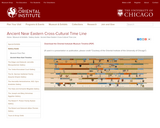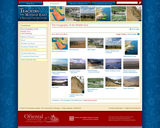
This timeline illustrates artifacts from ancient civilizations.
- Subject:
- Social Studies
- Material Type:
- Diagram/Illustration
- Provider:
- The Oriental Institute of The University of Chicago
- Date Added:
- 05/17/2017

This timeline illustrates artifacts from ancient civilizations.

In this lesson, students will understand how Mesopotamians solved the problem of record keeping and documenting in ancient times by using cylinder seals. They will work collaboratively to design a cylinder seal, test it out, and then write a reflection on the effectiveness of their plan.

This lesson offers a comparative analysis of both the Golden Age of Islam and the Age of Enlightenment and their significant contributions.

In this lesson, students will complete a comparative analysis of both time periods in history and their significant contributions. Students will understand the common themes of exploration, free thought, inquiry, and intellectual dialogue and discourse during the Age of Renaissance as well as the Golden Age of Islam. The module overview, from which the supplemental resources can be accessed, is located at http://teachmiddleeast.lib.uchicago.edu/foundations/golden-age-islam/index.html

In this lesson, students will analyze the use of imagery to symbolize the power of ancient kings and compare those images to those of modern famous men, either politically or culturally important figures. The module overview, from which the supplemental resources can be accessed, is located at http://teachmiddleeast.lib.uchicago.edu/historical-perspectives/rulership-and-justice/before-islam/index.html

In this lesson, students address influences and impact of colonial powers. Using assigned reading material along with the teachers' guidance, students will learn and understand the economic and political motives of the European powers and the effects on the social, cultural and religious structure of Imperial Muslim World. The module overview, from which the supplemental resources can be accessed, is located at http://teachmiddleeast.lib.uchicago.edu/historical-perspectives/empires-to-nation-states/islamic-period/index.html

In this lesson, students explore the concept of identity and the types of identities and their impact on individuals. The module overview, from which the supplemental resources can be accessed, is located at http://teachmiddleeast.lib.uchicago.edu/historical-perspectives/empires-to-nation-states/islamic-period/index.html

Students will examine some of the maps and artifacts of the empires of the ancient Middlle East in an effort to characterize them and compare and contrast them to modern states. The module overview, from which the supplemental resources can be accessed, is located at http://teachmiddleeast.lib.uchicago.edu/historical-perspectives/empires-to-nation-states/before-islam/index.html

In this lesson, students will examine some images to determine what they convey about the nature of empire and the capacity to express important cultural values. The module overview, from which the supplemental resources can be accessed, is located at http://teachmiddleeast.lib.uchicago.edu/historical-perspectives/empires-to-nation-states/before-islam/index.html

In this lesson, students will read about and examine visuals to compare and contrast the cities of the Middle East during the period between Alexander and Muhammed. The module overview, from which the supplemental resources can be accessed, is located at http://teachmiddleeast.lib.uchicago.edu/historical-perspectives/empires-to-nation-states/late-antiquity/index.html

In this lesson, students will research the various interpretations that explain the end of the Roman Empire and evaluate the factors that seem to contribute to the end of the empire. The module overview, from which the supplemental resources can be accessed, is located at http://teachmiddleeast.lib.uchicago.edu/historical-perspectives/empires-to-nation-states/late-antiquity/index.html

In this lesson, students will analyze the fundamental American political principle of separation of church and state by researching the impact of religion in ancient rulership. The module overview, from which the supplemental resources can be accessed, is located at http://teachmiddleeast.lib.uchicago.edu/historical-perspectives/rulership-and-justice/before-islam/index.html

In this lesson, students will read a tenth century history of early caliphs and evaluate their rule based on al-Mawardi's lists of qualifications and duties for a caliph. The module overview, from which the supplemental resources can be accessed, is located at http://teachmiddleeast.lib.uchicago.edu/historical-perspectives/rulership-and-justice/islamic-period/index.html

In this lesson, students will read an article about Sunnis and Shi'ites, then create a Venn diagram to plot similarities and differences between the two. The module overview, from which the supplemental resources can be accessed, is located at http://teachmiddleeast.lib.uchicago.edu/historical-perspectives/rulership-and-justice/islamic-period/index.html

In this lesson, students will examine the map of the Middle East and a series of visuals/images that illustrate the variations of the region.

The Geography of the Middle East: Image Resource Bank

In this lesson, students will visit several websites and briefly research an ethnic, religious, or language group from the Middle Eastern region. Student groups should prepare an oral presentation on their research.

In this lesson, students will work in peer groups to examine several samples from the image bank to compare historic representation of European (and American) cultural consciousness of Near Eastern antiquity and Middle Eastern society. The module overview, from which the supplemental resources can be accessed, is located at http://teachmiddleeast.lib.uchicago.edu/historical-perspectives/middle-east-seen-through-foreign-eyes/antiquity-modern/index.html

In this lesson, students will analyze ancient Egyptian mortuary practices, how this reflects in our understanding of ancient Egyptian culture, and how, in general, cultures are judges by their archaeological remains. The module overview, from which the supplemental resources can be accessed, is located at http://teachmiddleeast.lib.uchicago.edu/historical-perspectives/the-question-of-identity/before-islam-egypt/index.html

In this lesson, students will study information about the roles and responsibilites of women and men in ancient Egyptian society and then create a skit to reflect what they have learned. The module overview, from which the supplemental resources can be accessed, is located at http://teachmiddleeast.lib.uchicago.edu/historical-perspectives/the-question-of-identity/before-islam-egypt/index.html